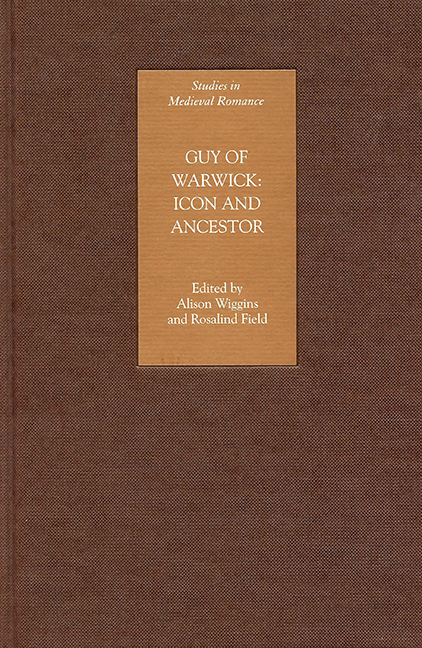Book contents
- Frontmatter
- Contents
- Illustrations
- Contributors
- Abbreviations
- Dedication
- Editorial Introduction: Namoore of this! How to read Guy of Warwick and why
- 1 Gui de Warewic at Home and Abroad: A Hero for Europe
- 2 Gui de Warewic in its Manuscript Context
- 3 Guy of Warwick as a Translation
- 4 From Gui to Guy: The Fashioning of a Popular Romance
- 5 The Manuscripts and Texts of the Middle English Guy of Warwick
- 6 The Speculum Guy de Warwick and Lydgate's Guy of Warwick: The Non-Romance Middle English Tradition
- 7 An Exemplary Life: Guy of Warwick as Medieval Culture-Hero
- 8 The Visual History of Guy of Warwick
- 9 ‘In her owne persone semly and bewteus’: Representing Women in Stories of Guy of Warwick
- 10 Of Dragons and Saracens: Guy and Bevis in Early Print Illustration
- 11 Guy of Warwick and The Faerie Queene, Book II: Chivalry Through the Ages
- 12 Guy as Early Modern English Hero
- Appendix: Synopsis of the Guy of Warwick narrative
- Index
5 - The Manuscripts and Texts of the Middle English Guy of Warwick
Published online by Cambridge University Press: 24 October 2017
- Frontmatter
- Contents
- Illustrations
- Contributors
- Abbreviations
- Dedication
- Editorial Introduction: Namoore of this! How to read Guy of Warwick and why
- 1 Gui de Warewic at Home and Abroad: A Hero for Europe
- 2 Gui de Warewic in its Manuscript Context
- 3 Guy of Warwick as a Translation
- 4 From Gui to Guy: The Fashioning of a Popular Romance
- 5 The Manuscripts and Texts of the Middle English Guy of Warwick
- 6 The Speculum Guy de Warwick and Lydgate's Guy of Warwick: The Non-Romance Middle English Tradition
- 7 An Exemplary Life: Guy of Warwick as Medieval Culture-Hero
- 8 The Visual History of Guy of Warwick
- 9 ‘In her owne persone semly and bewteus’: Representing Women in Stories of Guy of Warwick
- 10 Of Dragons and Saracens: Guy and Bevis in Early Print Illustration
- 11 Guy of Warwick and The Faerie Queene, Book II: Chivalry Through the Ages
- 12 Guy as Early Modern English Hero
- Appendix: Synopsis of the Guy of Warwick narrative
- Index
Summary
Before the era of print, there was no single standard text of the Middle English romance Guy of Warwick. Although Guy's legend was known in many regions and over an extended period, his status and portrayal were not always and everywhere the same. The manuscript record does not indicate a situation whereby a single dominant version of the romance was repeatedly copied and re-copied and thus disseminated around the country. Like the majority of Middle English romances, Guy of Warwick never had contact with any organizing production force of the kind that can, at least to some extent, be associated with those medieval texts that survive in higher numbers or which cluster around, or spread out from, a single point of origin. Rather, the textual and manuscript evidence implies a tradition which was far more erratic, fragmented, and decentred, and which was varied in terms of language, manuscript context, readership, and locality. The impulse to translate, copy, or compile Guy of Warwick was influenced and inspired at particular moments by specific cultural stimuli. Versions emerged and receded at different times and in different locales. There are instances of re-writing, adaptating, extracting, and combining versions of this, one of the most lengthy of Middle English romances, as it moved between different communities and environments. This chapter describes this mobile, animate, and responsive textual tradition and how versions of the romance came to be translated, adapted, discarded, or revived according to the interests of some of its earliest reading communities.
The situation is a dynamic one but it is worth pointing out that it is specifically and distinctively a written tradition. The romance (which is between eight and twelve thousand lines in the various Middle English versions) may have been read aloud from the manuscripts, but there is no evidence it was ever transmitted memorially or merged in any way with oral traditions. It is clear from the manuscript record, and from the kinds of very common othographic revisions and visual slips associated with copying, that the romance was transmitted in written form, copied from exemplars by scribes.
- Type
- Chapter
- Information
- Guy of Warwick: Icon and Ancestor , pp. 61 - 80Publisher: Boydell & BrewerPrint publication year: 2007

